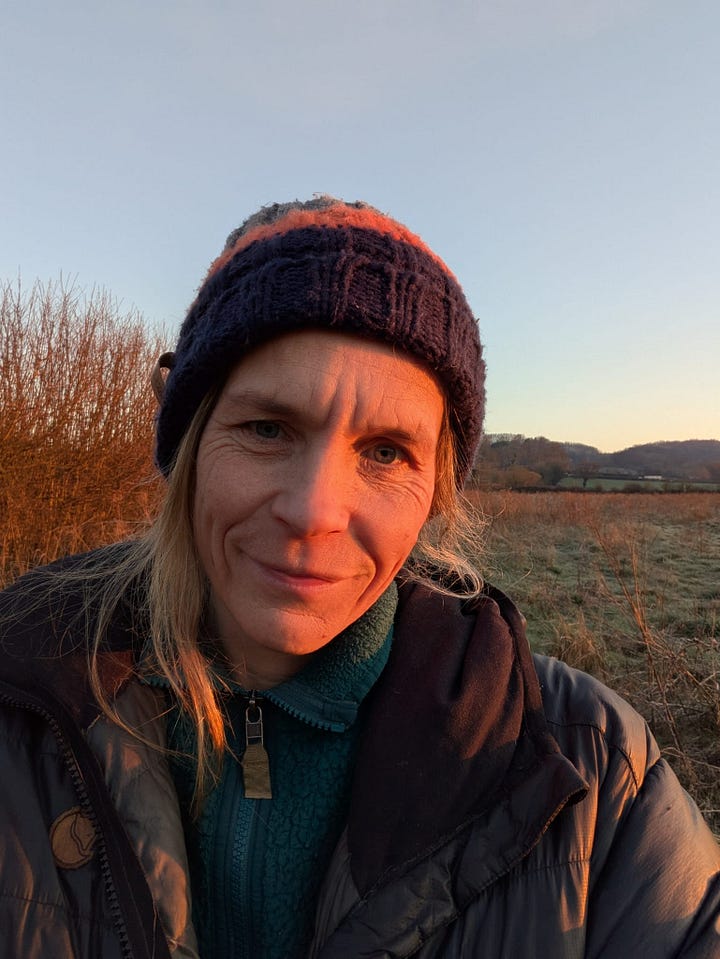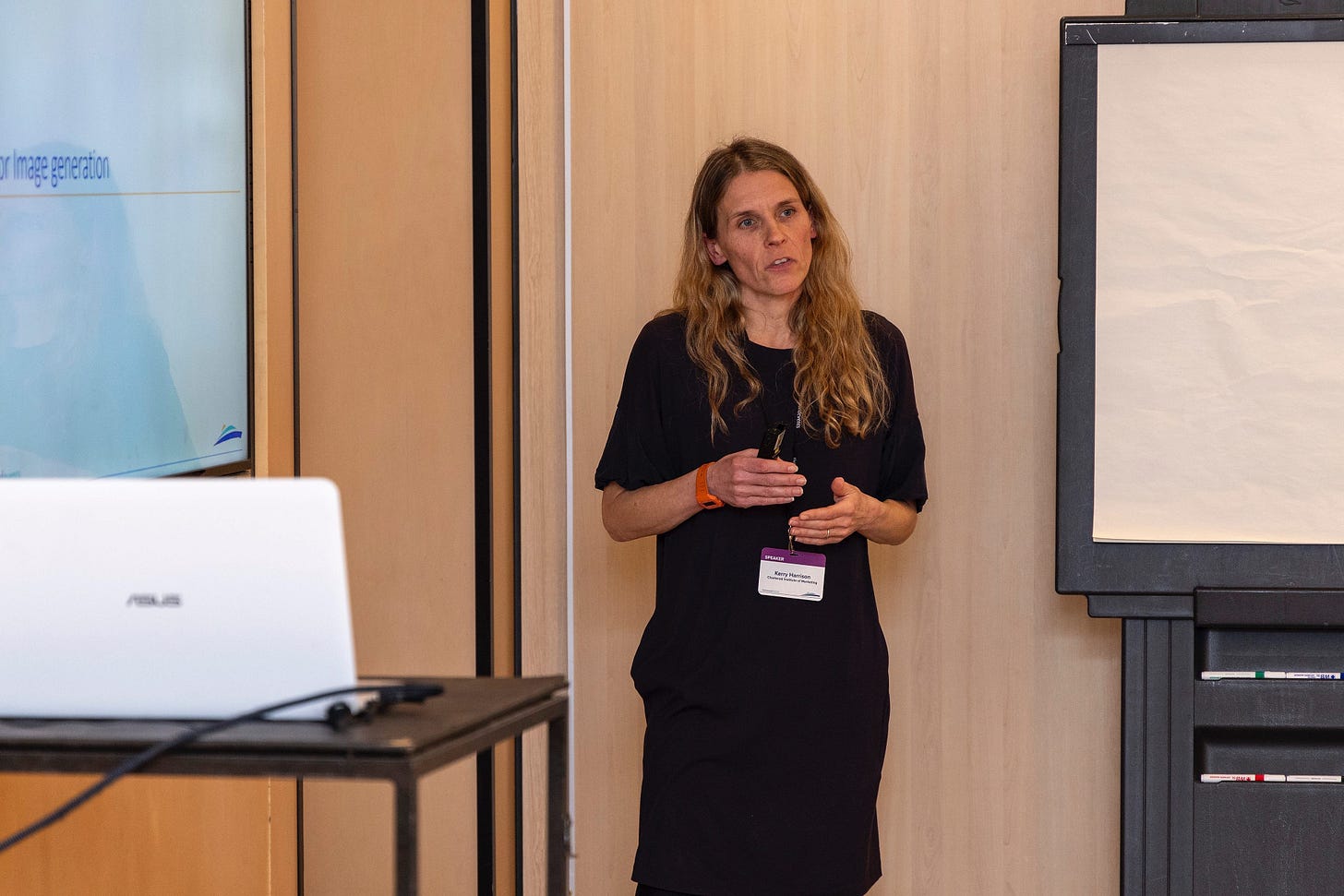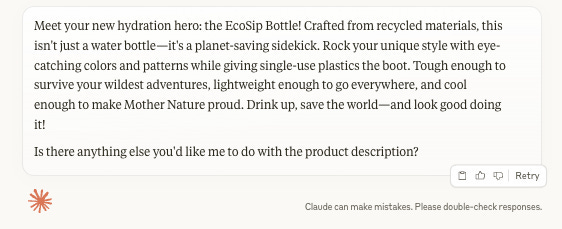#23 Minds & Machines: Does saying "please" improve outputs? + Why new models aren't always best
Plus, OpenAI's new writing tool, Sora lands in Europe & UK + the power of silence
I had a brilliant time speaking at the Richmond AI and Marketing Forum. Amazing people, food and location. Thanks to everyone who came to my session.
Hello, hello. I hope you’re good.
Sorry I’ve not sent a newsletter in a while. It’s been a bit bonkers.
I’ve spoken at events, taught my courses at the DMA and CIM. Plus, I delivered my first AI the Write Way course to a lovely bunch of micro business owners and got some nice feedback.
I’m doing it again in May with a different format – 3 shorter sessions over 3 days. You can book here.
This week, I’m running a workshop for AAR members and prepping for my next bunch of training for in-house marketing teams and agencies.
Tomorrow I’m also entering my third year of hosting seasonal women’s circles in the woods. I can’t wait to sit on a log, drink tea and write with pen and paper. There’s still a couple of spots if you can make it.
One more thing. I’m looking for guinea pigs for a new idea I’ve been exploring. It’s about taking my AI Sandwich method and seeing if it can be applied to creating inspiring AI-generated batched content.
It’s happening online on 9th May, 1pm - 2pm UK time. Grab your FREE ticket here. There are 8 spaces.
Right, shall we get on with the newsletter?
What’s inside this edition:
🤖 AI
Why the newest model isn’t always best
Sora now in the UK and Europe
Does saying “please” improve outputs?
Tools to try: Deep Research
Copyright – what you need to know
💛 The Human Element
The power of silence
👁️ AI that caught my eye
I absorbed heaps of AI news. These are my tops picks for copywriters and content creators.
New isn’t always best. Why writers might want to avoid the new Claude 3.7 upgrade.
Claude has had an upgrade. Claude 3.7 Sonnet is Anthropic’s most advanced model to date. It’s also described as the first hybrid reasoning model on the market (although you can do this in Grok too) .
Whereas ChatGPT has separate models, Claude lets you choose your thinking mode from the prompt box. If you want your model to think longer, click Extended Thinking in the drop down.
Extended thinking works best for maths and coding. But I find reasoning models helpful for problems that need pondering for a while. I’ve used it for business strategy, for example.
So why wouldn’t you use the new 3.7 model?
Well, 3.7 may look impressive on the benchmark tables, but (so far) I don’t think it’s as good for copywriting. It seems to have lost some of the personality and creativity that made Claude my go-to B2C copy assistant.
Quick example: a product description for a fictitious collapsible keep cup for 18-25 year olds. FYI: the tone keywords in my prompt were “fun, casual and quirky”, so it’s quite playful.
New 3.7 model
It feels quite ChatGPT-like. Stiffer and less creative than its last default tone.
Here’s the same prompt on the older model – 3.5 Haiku:
This feels more energetic, creative and colourful to me. Remember the tone cue was “fun, casual and quirky”. What do you think?
New isn’t always best
I’ve not done loads of side-by-side tests yet, so result may vary by use case.
But here’s the thing: while models improve in one area, the older version might still be best for your project.
So, before jumping headfirst into the shiny new model, just check it’s a better fit first.
Claude fans: noticed any difference since the upgrade? Are you reverting to 3.5?
OpenAI’s short story is “beautiful and moving” says Jeanette Winterson
Image generated on Midjourney
OpenAI has revealed it’s developing a model that’s “good at creative writing”, says Sam Altman.
The unnamed model hasn’t been released publicly yet but Altman said it’s the first time he’s been “really struck” by AI’s written output.
Of course, the CEO would say that. But when Jeanette Winterson is impressed, you have to take note.
Here’s the story and Winterson’s take.
What do you think? I’m not as enthusiastic as Winterson, but let’s see how this model shapes up.
Sora has landed in the UK and Europe
In early December, OpenAI’s released their video model, Sora. There was a flurry of AI-generated videos all over the web, but if you lived in the UK or Europe you couldn’t access it.
Well, now you can (if you’re on a paid ChatGPT plan).
Is it any good?
I’ve had mixed results so far. But I like the various features.
Remix
Change your video by describing what you’d like to alter. You can have subtle mild or strong adjustments.
Storyboard
Set prompts at different points to direct movement. I’ve found an establishing prompt plus one more works best. You can also upload images to direct the model.
Style presets
Use pre-defined styles including film noir, archival, cardboard & papercraft and whimsical stop motion.
I used an image from Unsplash as a guide on this one, plus my prompt.
I wanted the light to reflect more obviously off its wings. So this is a strong remix with the prompt: warm, golden hour lighting.
I also tried a capybara in a Parisian cafe using the Film Noir preset style.
Prompt: “A close-up shot reveals a capybara sitting comfortably at a small table in a cosy Parisian cafe. The capybara holds a steaming cup of hot chocolate with its front paws. Winter weather visible through the window, warm and comforting mood inside. People talking in the background.”
As I always say in my training, we’re still early days with video. It doesn’t always do what you ask. Although adding an image or video alongside your prompt really helps.
✨ AI Tools to Try
A detailed look at a recent AI tool and how it can help you.
Deep Research
Deep Research tools have been around for a little while. Gemini’s arrived in December for paying users (now available to everyone).
Now every model–ChatGPT (paid), Gemini, Grok, Perplexity–has a Deep Research capability. And they’re all called Deep Research!
What is Deep Research?
AI systems that work on their own to find, analyse and summarise information.
Unlike standard chatbot queries that take a few seconds, Deep Research takes longer (normally 2-4 mins). They models work through several steps to create a detailed report from various sources.
Why use Deep Research?
It can save you lots of time in gathering information for your project.
It will surface lots of sources that you can explore further.
Reports are delivered in an easy-to-read format, complete with heads and subs.
The reports cite sources (except in Grok).
Gemini and Perplexity name the sources they’ve explored – Gemini will tell you which ones were included in the report and which ones weren’t.
Which one is best?
You know what I’m going to say, don’t you? It depends.
Here’s a quick outline. I’ve done a like-for-like test on all four models.
Gemini - the speedy and neat one (FREE).
It’ll give you a plan of action before it starts, which you can edit.
Delivers well-organised reports complete with sources it used and didn’t use.
You can take your report straight into Google Docs.
ChatGPT - the exploratory one (PAID).
It seems to take a broader look at the topic.
Sources are clearly cited and it gave me useful insights.
It’s not as nicely organised as Gemini.
Perplexity - the concise one (FREE).
A more in-depth version of it’s standard search.
You’ll get lots more sources, clear citations and a concise answer.
I think it’s ideal if you want to easily check facts and get a brief on a topic.
Grok - The real-time rebel one (FREE).
Grok didn’t give me the breadth of info but went into depth on a couple of areas.
It draws from X, so offers real-time insights you might not get anywhere else.
The big downfall for me was the lack of citations.
Issues?
You’ll still need to be aware of hallucinations – sigh.
I spotted a couple of hallucinations in the outputs.
I was researching Cannes Lions award-winning campaigns that used AI. One model (ahhhem Gemini) came back citing a Nutella campaign which was apparently from 2025.
However, I was talking about that campaign in AI talks back in 2018! I’m also pretty sure it didn’t win a Cannes Lions.
SO, as ever, use AI models to speed up your research work – it certainly beats doing a billion Google searches. And you’ll have lots of information, interesting sources and a nice report as a solid foundation.
You’ll just need to analyse the report and double-check facts. Which isn’t too bad when you consider how much research you’ve just gathered in 2-4 minutes.
🧠 Governance + ethics
Policies, practices, frameworks and considerations for using AI responsibly
What’s going on with copyright and AI?
This is a question I get asked a lot in my talks and training.
We’ve heard a lot of news about AI and copyright laws lately. The EU AI Act outlined copyright obligations, the US made their stance clear and the UK has just finished its consultation to update the 1988 Copyright Act.
We’ve also seen 1,000 musicians release a silent album in protest against the UK government’s proposal to allow AI training on copyright-protected work.
So where are we at on the copyright front?
I’m no legal expert, but from a traditional Google search this is what I know:
US
AI-generated work is not copyrightable unless you select, coordinate and arrange AI-generated content in a sufficiently creative way.
EU AI Act:
Models must respect EU copyright law and honour “opt outs”.
Companies must publicly disclose information about data used to train models.
Copyright only applies to “author’s own intellectual creation”.
UK - Consultation closed 25th Feb. Proposed reforms could include:
Text and data mining (TDM) for commercial purposes, so developers can use copyrighted content for AI models.
Possible labelling of AI-generated or AI-manipulated work.
Allowing AI models to be trained on copyright-protected work unless you opt out.
We’ll have to see where it all goes.
💡 Prompting tips
Prompting tips and hacks to help you create your content
Does being polite to AI models give you a better response?
This is another question I get asked ALOT.
I know anthropomorphism is a concern, but I always say “please” in my prompts.
I believe that if we talk to AI models like crap, this can translate into the way we talk to people in general. We have to think about how our use of technology shapes us and society.
I’ve also read research papers that say you’ll get better outputs with politer prompts.
Earlier this month, Ethan Mollick shared his research paper which showed “please” worked well for some questions, but not for others.
“Prompting “tricks” like politeness are not universal. While we observed significant differences in performance across individual questions under all conditions, such differences became negligible once aggregated across the entire dataset.”
Here’s the graph in the research paper and his post on the research.
I’d love to know more about the questions and when “please” or “I order you” made the biggest difference. But either way, I’ll still be polite in my prompts.
💛 The Human Element
A celebration of our wild minds and creative souls


The power of silence
I love the Friday morning newsletter from Dark Angels. I read it however busy I am. This week’s email was about silence and included an invite to a silent Zoom call. Nice.
It got me thinking.
Is it just me, or does the world seem extra noisy right now? Our never-ending social feeds, autoplay defaults, the constant need to show up and say something, digital notifications and pings.
Our attention is forever being pulled away from silence.
Yet silence has a lot to give us:
It can lower stress and cortisol levels, calming racing thoughts.
It gives our brains time to process information and integrate experiences.
It boosts creativity, creating space for our minds to wander, make new connections and access deeper creative thinking.
It can improve relationships. Being silent with someone might help us connect more meaningfully. I think silence can often say more than words.
It improves self-awareness, helping us recognise our thoughts and feelings. I've found a big dose of self-compassion helps with holding uncomfortable feelings. Equanimity is one of my ongoing personal journeys.
Around 4 years ago, I realised busyness was my way of hiding from feelings. I’ve slowly become more comfortable with silence and stillness. Daily (ish) meditations and turning off most notifications has helped me to see more clearly and find a bit of calm.
Even a five minute cuppa before the house wakes up can do wonders.
What’s your relationship to silence?
☀️ Upcoming human adventures
My upcoming public talks, workshops and events
Yoga and Creativity Retreat: we have a few spaces left on our women’s weekend in Hampshire Glow Retreat. Date: 20-22nd June 2025.
My Spring Equinox Women’s Circle: Writing in the Woods is available to book. Grab your journal and come sit around the fire with a cuppa. This is time to unwind, connect with others – and uncover your thoughts with good old pen and paper.








